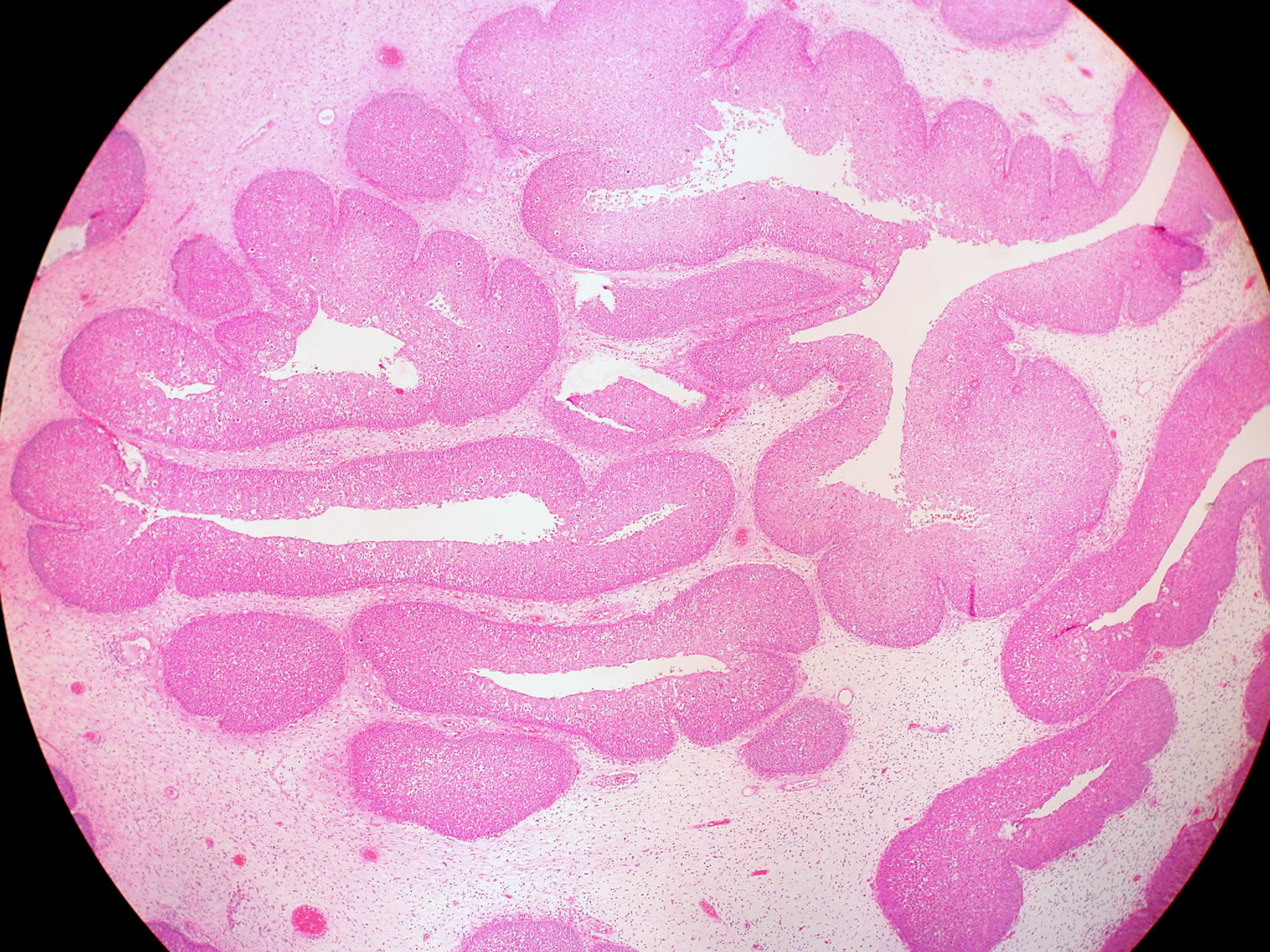Tumors of the nose and paranasal sinuses
Tumors of the nose and paranasal sinuses are very common in their benign form. Malignant tumors, on the other hand, are relatively rare (they make up less than 1% of all malignant tumors and about 3% of all head and neck tumors). The incidence of tumors increases with age (maximum in the 6th - 7th decade of age). Men are affected twice as often. The most common benign tumors are inverted papilloma, angiofibroma, fibrous dysplasia and osteoma. Malignant tumors are most often represented by squamous cell carcinoma.
Symptomatology[edit | edit source]
Most tumors often remain silent. We typically find unilateral involvement that has non-specific symptoms:
- worsening of nasal patency;
- repeated bleeding;
- nasal discharge;
- recurrent inflammation of the paranasal sinuses.
If the tumor progresses, surrounding structures may be affected: orbital, oral, skull base, facial, CNS
Benign Tumors[edit | edit source]
Papilloma[edit | edit source]
 It is an epithelial neoplasia that arises in connection with infection with HPV 6 and 11 (human papillomavirus types 6 and 11). They form pedunculated papillary formations, sometimes multiple. The basis is fibrovascular stroma, which is covered by cylindrical respiratory epithelium or squamous metaplastic. These are mostly benign tumors, but they can recur. Malignant transformation is rare.
It is an epithelial neoplasia that arises in connection with infection with HPV 6 and 11 (human papillomavirus types 6 and 11). They form pedunculated papillary formations, sometimes multiple. The basis is fibrovascular stroma, which is covered by cylindrical respiratory epithelium or squamous metaplastic. These are mostly benign tumors, but they can recur. Malignant transformation is rare.
Papillomas occur in three forms:
- inverted form - the most common, lateral wall of the nasal cavity, paranasal cavity
- exophytic form - nasal septum
- oncotic form - lateral wall of the nasal cavity, paranasal cavity
Juvenile angiofibroma[edit | edit source]
 I also call it as nasopharyngeal angiofibroma. It occurs in the nasopharynx, more often in young men. It is characterized as a well-circumscribed, polyploidy arranged tumor. The bearing is usually prone to bleeding. From a microscopic point of view, it consists of dilated blood vessels, minimal inflammatory infiltrate and numerous fibroblasts or fibrous stroma. It often regresses during puberty, especially after incomplete surgical excision.
I also call it as nasopharyngeal angiofibroma. It occurs in the nasopharynx, more often in young men. It is characterized as a well-circumscribed, polyploidy arranged tumor. The bearing is usually prone to bleeding. From a microscopic point of view, it consists of dilated blood vessels, minimal inflammatory infiltrate and numerous fibroblasts or fibrous stroma. It often regresses during puberty, especially after incomplete surgical excision.
Malignant tumors[edit | edit source]
Carcinoma[edit | edit source]
Different types of cancer can occur quite often in the area of the nasal cavity and paranasal sinuses:
- squamous cell carcinoma;
- glandular carcinoma;
- mucoepidermoid carcinoma.
As far as the paranasal sinuses are concerned, cancer most often arises from the sinus maxillaris. These tumors can grow invasively into the orbit and into the cranial cavity. In an advanced stage, an enlarged tumor can deform the face and even penetrate the skin of the face.
Olfactory neuroblastoma[edit | edit source]
 This malignant neuroectodermal tumor (sometimes called estezioneuroblastoma) usually arises in the ceiling of the nasal cavity. It forms at the place of the cribriform plate. Microscopically, neuroblastic differentiation is visible. It occurs most often in individuals of the 4th-5th decade.
This malignant neuroectodermal tumor (sometimes called estezioneuroblastoma) usually arises in the ceiling of the nasal cavity. It forms at the place of the cribriform plate. Microscopically, neuroblastic differentiation is visible. It occurs most often in individuals of the 4th-5th decade.
Diagnosis[edit | edit source]
The following is important for diagnosis:
- anamnesis;
- rhinoendoscopy;
- CT, MRI - defines the extent of the tumor and its relationship to the surroundings;
- angiography - for vascular tumors.
Therapy[edit | edit source]
Surgical resection is commonly performed for benign tumors. If it is a malignant tumor, then complex oncological treatment is needed. In this case, the scope of treatment is planned according to the TNM classification.
Links[edit | edit source]
Related Articles[edit | edit source]
External links[edit | edit source]
- SVÁROVSKÝ, Jiří. Tumors of the nasal cavity and paranasal sinuses [online]. ©3/2012. [cit. 2019-03-26]. <https://www.tribune.cz/clanek/25896-nadory-nosni-dutiny-a-vedlejsich-dutin-nosnich>.
- XU, Bin. Olfactory neuroblastoma [online]. ©2018. [cit. 2019-03-26]. <http://www.pathologyoutlines.com/topic/nasalolfactoryneuroblastoma.html>.
References[edit | edit source]
- POVÝŠIL, Ctibor. Speciální patologie. 1. edition. Praha : Galen, 2007. 430 pp. ISBN 9788072624942.
